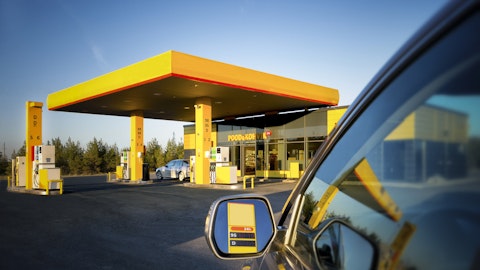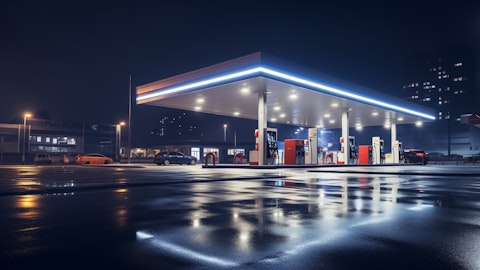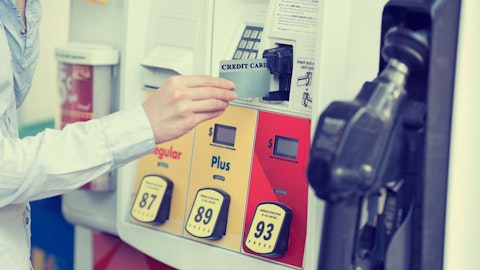Andrew Clyde : Bobby, that’s a great question. And certainly, if you’ve got a 2-year stack, you could just kind of rest on that and make that your answer. As you know, we’re not that complacent when we look at our business. I mean, I’ll give you an example on a sales basis, center store was down. And on a 2-year stack, only up 2%. Food and beverage was up 7% on a 2-year stack, but only up 1.1% on a margin basis. And so as I think about the big initiatives that we are in the midst of, and as I noted, we are ahead of schedule in terms of both execution and delivery, they’re all focused on nontobacco merchandise, including food and beverage. Some examples. Our price and SKU optimization for the center of the store, we’ve got really good at fuel pricing and tobacco pricing.
We’re now applying that to the center of the store. The demand forecasting work we’ve done at Quick Check is going to improve production planning and labor planning, we’re already seeing it flow to the bottom line from both a margin and a cost standpoint, along with the pricing improvements that we made that will flow through and full year results next year. MDR is great. We’re now personalizing offers in a much more sophisticated way than we’ve ever done before. Everyone knows Murphy USA is great for upselling. Now we’re doing a better job of doing that at Quick Check, especially on the food and beverage side with the digital customer order screens. Our in-store experience campaign, we’ve got 17% more selling space in the center of the store.
We’ve adopted 2 lines from Quick Check. The food and beverage layout has been redesigned for an expanded grab-and-go and dispensed beverage area. So I think your point is spot on, and that’s where a significant amount of our focus has been this year on improving that part of the business, and I expect to see really good results on that in 2024.
Operator: Your next question comes from the line of Bonnie Herzog.
Ethan Huntley: This is Ethan Huntley on for Bonnie Herzog. I guess first, maybe a topic of discussion lately has been GLP-1 drugs. So I’m curious to hear your thoughts on the potential impact on your business from the growing use of these drugs. I guess, sort of have you seen any impact on your inside sales or any changes in consumer behavior either from a basket traffic or maybe a category perspective? And then maybe if you could touch on your initiatives you could implement sort of to mitigate these potential impacts over the next, say, 5 to 10 years?
Andrew Clyde : Yes. I think it’s way too early to tell.
Ethan Huntley: Okay. All right. Got it. And then maybe let’s talk about fuel margins again. We’ve come quite a bit, but curious if you can maybe help outline the impact of a tight diesel fuel supply market had on your margins and volumes during the quarter. And I guess, sort of any color you can provide on that dynamic more recently.
Mindy West : I mean, as you know, we are more or focused, more gasoline focused versus diesel. So while that had an impact, that was really just on the margin for the most part, the margins that we were able to drive home in the quarter were really more a function of our execution against our strategy, also the persistent market structure equilibrium, which continues to pressure retailers, as Andrew said, to raise margin to cover cost. Margins coming into July were a little soft, and we had 3 separate price moves on a Friday, which challenged us, but we were able to recover from that in the months of August and September posting really strong results. And so really, it’s just our executing against our strategy in that market equilibrium, which is allowing us to continue to generate that strong cash flow and earnings even at a relatively stable market environment.
And of course, we would be able to have significant upside if we ever get a return to volatility, which we certainly will. So as Andrew said, as we look out into October in the fourth quarter, we continue to be encouraged by the traffic in our store with volumes right near last year’s and at much higher margins, at least so far in the fourth quarter. So diesel not really having a material impact on the bottom line for our results at least.
Andrew Clyde : Yes. I think the other thing you have to think about is I drive a diesel truck. Most of our customers who are driving a diesel truck on a farm or a ranch or an oil field or something like that, they’re not switching out because of the mission of that vehicle, to a gasoline vehicle because of the requirements they have. So it’s really a nondiscretionary purchase for them. Fortunately, we’re not having supply outages or anything else because of the tightness as well in the ag season has kicked off to a good start, and that’s certainly helping volumes out of our proprietary terminals. So something you keep an eye on, but it’s not impacting the business in any negative or major way.
Operator: And your next question comes from the line of Corey Tarlowe with Jefferies.
Corey Tarlowe : Firstly, Andrew, I believe you had mentioned that you’re piloting, I believe, 9 stores with the redesigned interior and improved food and beverage with the potential to scale that or renovate up to 50 stores next year. Could you talk a little bit about the early performance that you’re seeing from these stores and what’s different in these stores versus your more traditional stores?
Andrew Clyde : Yes. So it’s too early to give you detailed performance data. We’re kind of a month or so into that. But so far, customer feedback is extremely encouraging as well as feedback from the staff. In fact, we have teams out there of our leadership teams visiting the 3 markets those are in. So part of the feedback we got is our food and beverage strategy was around how the store is organized, where the food and beverage offer is presented in the store. And so if you walk in now, you’ll see grab and go at the back of the store versus where it was closer to the front. One of the things that we had to do because it was in the front was put more shading on the windows to keep the refrigeration stable. Customers didn’t like all the shading on the windows because the store wasn’t as open, transparent and lift from a perceived hey, I look in the store if it looks dark, that’s not as good a sense.



